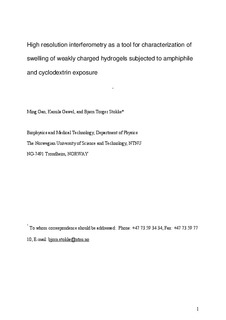| dc.contributor.author | Gao, Ming | |
| dc.contributor.author | Gawel, Kamila | |
| dc.contributor.author | Stokke, Bjørn Torger | |
| dc.date.accessioned | 2017-09-01T12:00:44Z | |
| dc.date.available | 2017-09-01T12:00:44Z | |
| dc.date.created | 2013-02-14T08:42:32Z | |
| dc.date.issued | 2013 | |
| dc.identifier.citation | Journal of Colloid and Interface Science. 2013, 390 (1), 282-290. | nb_NO |
| dc.identifier.issn | 0021-9797 | |
| dc.identifier.uri | http://hdl.handle.net/11250/2452786 | |
| dc.description.abstract | A high resolution interferometric technique was used to determine swelling behavior of weakly charged polyacrylamide hydrogels in the presence of oppositely charged surfactants and subsequent exposure to cyclodextrins. Hydrogels of copolymerized acrylamide and 2-acrylamido-2-methyl-1-propanesulfonic acid (0.22, 0.44, 0.88 mol%) and crosslinked with bisacrylamide (3, 6, 12 mol%) were employed. The equilibrium swelling and swelling kinetics of the hydrogels were determined with 2 nanometer resolution of the optical length and sampled at approximately 1 Hz. These properties were determined for the hydrogels exposed to cationic surfactants dodecyltrimethylammonium bromide (DTAB) and cetyltrimethylammonium bromide (CTAB) at concentrations from 10-7 up to 2•10-3 M. The distribution of surfactants within AAM-co-AMPSA hydrogel was investigated by confocal laser scanning microscopy imaging of chosen hydrogel equilibrated in CTAB/perylene solution. Hydrogels equilibrated at selected surfactant concentrations were subsequently exposed to cyclodextrins (α-CD, β-CD, methyl-β-CD and γ-CD) forming inclusion complexes with the surfactants. The results show different type of behavior for the two surfactants used, arising from the differences in the length of surfactant hydrophobic tail. The changes in the surfactant induced swelling of the hydrogels are suggested to arise from the net effect of electrostatic screening of sulfonic acid – amide group interactions and surfactant micellization. Hydrogels with the largest charge density and lowest crosslink density yielded the most pronounced changes in swelling properties on exposure to DTAB or CTAB. The hydrogels displayed swelling kinetics on stepwise changes in surfactant concentrations that depended on the surfactant concentration range. The high resolution monitoring of hydrogel swelling associated with supramolecular complex formation in a three-component system hydrogel - amphiphilic molecule - cyclodextrin provide more details in the swelling behavior than previously disclosed. | nb_NO |
| dc.language.iso | eng | nb_NO |
| dc.publisher | Elsevier | nb_NO |
| dc.rights | Attribution-NonCommercial-NoDerivatives 4.0 Internasjonal | * |
| dc.rights.uri | http://creativecommons.org/licenses/by-nc-nd/4.0/deed.no | * |
| dc.title | High resolution interferometry as a tool for characterization of swelling of weakly charged hydrogels subjected to amphiphile and cyclodextrin exposure | nb_NO |
| dc.type | Journal article | nb_NO |
| dc.type | Peer reviewed | nb_NO |
| dc.description.version | acceptedVersion | nb_NO |
| dc.source.pagenumber | 282-290 | nb_NO |
| dc.source.volume | 390 | nb_NO |
| dc.source.journal | Journal of Colloid and Interface Science | nb_NO |
| dc.source.issue | 1 | nb_NO |
| dc.identifier.doi | 10.1016/j.jcis.2012.09.020 | |
| dc.identifier.cristin | 1010210 | |
| dc.relation.project | Norges forskningsråd: 191818 | nb_NO |
| dc.description.localcode | Copyright © 2012 Elsevier Inc. All rights reserved. This is the authors' accepted manuscript to the article. | nb_NO |
| cristin.unitcode | 194,66,20,0 | |
| cristin.unitname | Institutt for fysikk | |
| cristin.ispublished | true | |
| cristin.fulltext | postprint | |
| cristin.qualitycode | 1 | |

